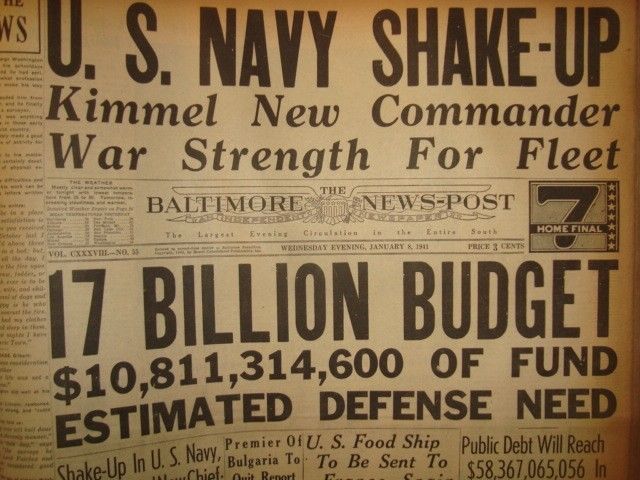Saturday 11 January 1941
 |
| RAF bombing the port of Valona, Albania, 11 January 1941. (AP Photo). |
European Air Operations: The Luftwaffe, true to form, hits Portsmouth again for the second night in a row. A lucky hit on the main water main while the tide is out - the Luftwaffe has been planning raids in conjunction with the tides recently, to good effect - cripples firefighting efforts. The one saving grace for the British is that many locals have gone elsewhere for this Saturday night. The City of London also is attacked by 137 aircraft. A bomb penetrates Bank Station, killing 51 people and causing a crater so large that the army has to build a bridge across it.
RAF Bomber Command sends 16 bombers over Wilhelmshaven in another attempt to bomb German battleship Tirpitz. There are no hits and no losses to either side. Other bombers hit Turin with good accuracy, starting fires at both the Royal Arsenal and a ball-bearing factory.
 |
| Royal Hospital, Commercial Road, Portsmouth, on January 11, 1941. During the attack on the hospital, a doctor, a constable, and several male nurses were killed. |
The Focke-Wulf Fw-200 Condors of I,/KG 40 achieve another victory today in the shipping lanes west of Ireland. They sink 1600-ton convoy rescue ship HMS Beachy. There are 5 deaths, and the survivors in their lifeboat are not picked up until the 29th.
Swedish 1216-ton freighter Bertha hits a mine and sinks between Saltholm and Middelgrundens, Denmark. There are four deaths and 13 survivors.
British 172-ton fishing boat Oriole hits a mine and sinks off Stakken North Point, Faroes. Everyone on board perishes.
German 679-ton freighter Brechsee hits a mine and sinks off Malmö, Sweden. Some sources place this as happening on the 21st.
The Luftwaffe also bombs and damages 1142-ton British freighter Greyfriars off Grimsby, near Hull. There are five deaths. The freighter drifts ashore but is later salvaged and taken to Hull for repairs.
British 8465-ton tanker British Fidelity hits a mine and is damaged in the Bristol Channel. It is towed to Cardiff.
Royal Navy 92-ton drifter Uberous runs aground off Londonderry and is wrecked.
US liner Manhattan runs aground off Lake Worth Lagoon, Florida, about nine miles south of Palm Beach. The captain and first officer both are later suspended for negligence in this incident. The ship is refloated and repaired just over three weeks later.
Convoy FN 381 departs from Southend, Convoy BN 12A departs from Aden, Convoy HX 102 departs from Halifax.
U-598 laid down.
The Luftwaffe continues its attacks on the Royal Navy warships involved in Operation Excess, and once again draws blood. Having damaged heavy cruiser HMS Southampton on the 10th, Fliegerkorps X (2 Staffeln, Sturzkampfgeschwader 2) returns in the afternoon and finishes the job. The cruiser is hit three more times and must be abandoned. Cruiser HMS Gloucester, traveling in company with Southampton, also is hit (a bomb passes through five decks without exploding) and set on fire (9 deaths). Italian submarine Settimo fires three torpedoes at the Southampton, but it remains afloat. Royal Navy submarine HMS Orion later administers the kill shot. There are 668 survivors of Southampton, 80 dead and 87 other casualties (accounts vary on exact numbers).
Operation Excess basically concludes. Perversely, all the freighters and warships carrying troops and equipment reach Malta without any damage. However, the Royal Navy has lost destroyer HMS Gallant and light cruiser HMS Southampton, while having new aircraft carrier HMS Illustrious damaged to the point of sinking. Overall, Operation Excess has been a disaster for the Royal Navy due to the new, unexpected presence of the Luftwaffe operating out of Sicily.
On land, the Australians and English tighten their hold on Tobruk. General Wavell will have to complete its capture soon before Greece sucks up more of his remaining troops.
In Malta, the dockyard workers swarm over Illustrious in order to make her seaworthy again. They ignore the mangled flight deck and instead concentrate on repairing leaks and the ship's steering.
In southwest Libya, the British Long Range Desert Group (LRDG) boldly drives south into Murzuk, their objective, after almost being spotted by an Italian reconnaissance plane. They drive straight through town to the Beau Geste fort at the southern end. En route, they capture the town's postmaster, Signore Colicchia, who they find cycling toward the fort with the day's mail. The sentries in the fort spot the approaching British vehicles (23 in all) and close the gate. The LRDG then splits up, with half remaining outside the fort to contain the garrison while the rest go to shoot up the nearby airfield.
At the airfield, the LRDG men subdue about 20 soldiers guarding three Ghibli light bombers. They then destroy the planes and the hangar. Pat Clayton, in command of the New Zealanders, takes out an Italian machine-gun nest by driving over it. After destroying everything worthwhile there, the LRDG reforms in town and destroys the Italian fuel stores, ammunition, and everything else worthwhile in the town. They also damage the Murzuk fortress, which is impregnable to their light arms. The LRDG then leaves the town at about 16:00 and heads back toward British lines the way they had come. Overall, the Italians have ten killed and fifteen wounded, while the British lost two men and three wounded.
The raid has a devastating effect on Italian morale. The attack was completely unexpected and far behind the front. Damage at Murzuk airfield is never repaired, and in fact, remains exactly as the LRDG left it for decades after. More than any other single incident, this raid creates the legend of the LRDG.
 |
| The LRDG attack on Murzuk, 11 January 1941. |
German Military: Following his most recent round of discussions with his military staff at the Berghof, Adolf Hitler issues Fuhrer Directive No. 22, "German Support For Battles In The Mediterranean Area." In essence, it aims to prop up the Italian effort in the Mediterranean, both in Albania and North Africa. For the first time, Hitler specifies that Germany will provide "covering forces" for the defense of Italian North Africa, and also in Albania.
Hitler proposes to move the "approximate strength" of one army corps, which he specifies will include the 1st Mountain Division. He is not so specific about German forces in North Africa, though, saying that "Special orders for the composition of this force will follow." The Albanian transfer is to happen first, and then, once shipping is freed up, the transfer of forces to North Africa. This Directive is the germination of the Deutsches Afrikakorps.
This directive is an admission of weakness, not strength, in the Axis. While Hitler gives passing lip service to "Italian approval" of these troop movements, the Italians have been asking for help for a month. Fuhrer Directive No. 22 is only necessary because of Italian military failures, and while Germany has plenty of military force available and sitting idle, this directive opens up an entirely new sector of German responsibility that it never should have had to worry about. There is a vast amount of territory to cover in the Mediterranean, and it would have been vastly better for the Axis if the Italians had been able to hold their own there - but they can't.
The Luftwaffe's presence in the Mediterranean, also specified in the Fuhrer Directive, already is paying dividends, as discussed above. These forces are to be augmented and sent against British assets throughout the Mediterranean under the codename Operation Alpine Violets.
 |
| HMS Southampton, sunk today. |
US Military: The US Army Air Corps orders two prototypes of the Northrop XP-61, along with two wind-tunnel models. This is a large, all-metal, twin-boom fighter carrying a crew of three. The XP-61 is designed to be a heavily armed night fighter used to intercept Luftwaffe bombers attacking London at night. Lieutenant General Delos C. Emmons, based in London, has used the latest progress by the British in airborne radar to craft the requirements and specifications for this plane. Ultimately, this project will turn into the Northrop P-61 Black Widow. This is the second twin-boom fighter design for which the USAAC has ordered prototypes recently, the other being the Vultee XP-54 on 8 January 1941.
The US command problems at Cavite in the Philippines continue. Rear Admiral Harold M. Bemis relieves Captain Eugene T. Oates as Commandant, the Sixteenth Naval District and Navy Yard. Oates had just replaced Rear Admiral John M. Smeallie in December. Many consider these rapid-fire command changes to be a major factor in the US's lack of preparedness when the time comes for... action.
Dutch Military: The Government-in-exile begins forming the Princess Irene Brigade.
French Indochina: The Thai Army continues to attack into the Mekong Delta.
China: The Nationalist Chinese (Kuomintang) continue to press in on encircled elements of the Communist Chinese New 4th Army at Maolin on the Yangtze River.
American Homefront: William Randolph Hearst has banned his chain of newspapers from covering RKO pictures due to his outrage over Orson Welles' forthcoming "Citizen Kane." The front page of today's Daily Variety screams, "HEARST BANS RKO FROM PAPERS." Hearst has his lawyers working over the weekend to draft a temporary restraining order to enjoin RKO from distributing "Citizen Kane," which Hearst feels is personally defamatory. So far, RKO remains determined to release the picture. He also continues to look for other means to apply pressure on the studio.
 |
| "Store Gift Exchange," with art by Douglass Crockwell. Saturday Evening Post - January 11, 1941. |
January 1941
January 1, 1941: Muselier ArrestedJanuary 2, 1941: Camp Categories
January 3, 1941: Liberty Ships
January 4, 1941: Aussies Take Bardia
January 5, 1941: Amy Johnson Perishes
January 6, 1941: Four Freedoms
January 7, 1941: Pearl Harbor Plans
January 8, 1941: Billions For Defense
January 9, 1941: Lancasters
January 10, 1941: Malta Convoy Devastation
January 11, 1941: Murzuk Raid
January 12, 1941: Operation Rhubarb
January 13, 1941: Plymouth Blitzed
January 14, 1941: V for Victory
January 15, 1941: Haile Selassie Returns
January 16, 1941: Illustrious Blitz
January 17, 1941: Koh Chang Battle
January 18, 1941: Luftwaffe Pounds Malta
January 19, 1941: East African Campaign Begins
January 20, 1941: Roosevelt 3rd Term
January 21, 1941: Attack on Tobruk
January 22, 1941: Tobruk Falls
January 23, 1941: Pogrom in Bucharest
January 24, 1941: Tank Battle in Libya
January 25, 1941: Panjiayu Tragedy
January 26, 1941: Churchill Working Hard
January 27, 1941: Grew's Warning
January 28, 1941: Ho Chi Minh Returns
January 29, 1941: US Military Parley With Great Britain
January 30, 1941: Derna Taken
January 31, 1941: LRDG Battered
2020



















